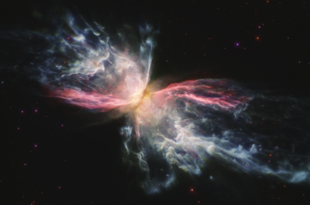NGC 6302
| Planetarischer Nebel NGC 6302 | |
|---|---|
 | |
| Aufnahme des Hubble-Weltraumteleskops | |
| AladinLite | |
| Sternbild | Skorpion |
| Position Äquinoktium: J2000.0 | |
| Rektaszension | 17h 13m 44,6s [1] |
| Deklination | −37° 06′ 11″[1] |
| Erscheinungsbild | |
| Scheinbare Helligkeit (visuell) | 9,6 mag [2] |
| Scheinbare Helligkeit (B-Band) | 12,8 mag [2] |
| Winkelausdehnung | 1,48′ × 1,48′ [2] |
| Zentralstern | |
| Bezeichnung | HD 155520 |
| Physikalische Daten | |
| Rotverschiebung | −0,000119 [3] |
| Radialgeschwindigkeit | −35,7 km/s [3] |
| Entfernung | 3800 ± 460 Lj |
| Alter | 7.500 Jahre |
| Geschichte | |
| Entdeckung | James Dunlop |
| Datum der Entdeckung | 5. Juni 1826 |
| Katalogbezeichnungen | |
| NGC 6302 • PK 349+1.1 • ESO 392-PN5 • Sh2-6 | |
NGC 6302, auch als Käfer-Nebel bezeichnet, ist ein planetarischer Nebel im Sternbild Skorpion, welcher 4000 Lichtjahre von der Erde entfernt ist. NGC 6302 wurde von einem alternden Stern mit der Bezeichnung HD 155520 gebildet, als dieser seine äußere Hülle in Form von extrem schnellen Gasströmen in den vergangenen 2200 Jahren abgestoßen hat.[4]
Das Objekt wurde am 5. Juni 1826 vom amerikanischen Astronomen James Dunlop entdeckt.[5]
Literatur
- König, Michael & Binnewies, Stefan (2023): Bildatlas der Sternhaufen & Nebel, Stuttgart: Kosmos, S. 233
Weblinks
- GoBlack
- Bild von der ESO
- astronews.com: Bild des Tages 8. Oktober 2009
- Spektrum.de: Amateuraufnahmem [1]
Einzelnachweise
- ↑ NASA/IPAC EXTRAGALACTIC DATABASE
- ↑ a b SEDS: NGC 6302
- ↑ SIMBAD
- ↑ Hubble enthüllt Schmetterling. In: Spektrum der Wissenschaft. November 2009, S. 15.
- ↑ Seligman
Auf dieser Seite verwendete Medien
Autor/Urheber: Judy Schmidt from USA, Lizenz: CC BY 2.0
New observations from 2019 (Prop 15953/Joel Kastner) reveal [Fe II] emission, shown here in pink, along the edges of the biopolar outflows of this young planetary nebula. I created this image specifically to clearly detail this discovery, deliberately arranging filters and assigning colors that would draw one's eyes to the new emission line data.
Hat tip to Bruce Balick for his original idea of removing the stars in the [Fe II] data. Through a strange series of emails I ended up "stealing" this idea, but he seemed happy about it when confession time came.
Data from the following proposals were used to create this image: WFC3 ERO: Planetary Nebula Young and Rapidly Evolving: a Panchromatic WFC3 Imaging Study of the Planetary Nebulae NGC 7027 and NGC 6302
Note that stars were manually removed from the F164N/[Fe II] data.
Red screen: F164N ([Fe II]) Red: F673N Yellow-Green: F658N Blue: F373N
North is 35.20° clockwise from up.Autor/Urheber: Roberto Mura, Lizenz: CC BY-SA 3.0
Caldwell Catalogue objects.


